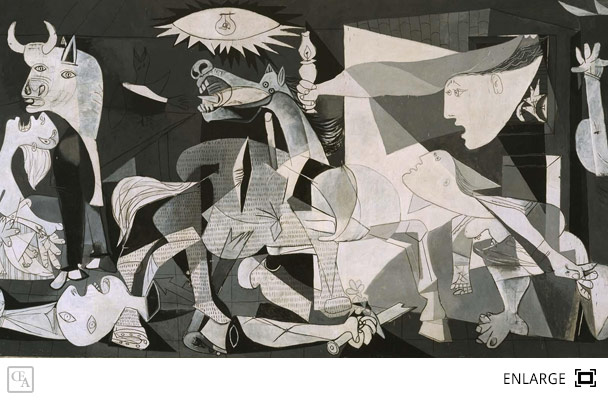
During the war, German forces, which were backing General Franco, bombed a city filled with civilians for hours until it was a reduced to mere ruins. There were 1600 casualties, and roughly ¾ of the city was destroyed completely. The event was merely a calculated military exercise designed to test new methods of war, as the city had no militaristic significance and the attack provided no strategic advantage in the war. This massacre of innocents deeply touched Picasso, and while he had been uninterested in depicting political subjects before, the gruesome event inspired him to portray the misery and destruction of war.
Initially, Picasso was going through an uncreative period, grudgingly working on a painting that had been commissioned by the Spanish government for the World's Fair. He began to work more passionately once Juan Larrea inspired him to create a work about the massacre in Guernica. Moved by the tragedy and by feelings of sympathy for the government of his home country, he produced a very striking—even shocking—image of the event that immediately resonated with audiences and brought awareness to the Republican Spain's cause.
The painting itself is very large, closer in size to a mural, as it is nearly 3.5 meters in height and about 7 and ¾ meters in length. This size is designed to immerse the viewer in its imagery, to make the viewer feel as if he is trapped within the landscape of war, and this creates a much stronger emotional response. The painting is epic in its scope, showing the death and destruction of many characters, both human and animal, as well as the overall devastation of a city that had huge cultural significance to the Basques. In spite of its known meaning, the individual elements of the painting are somewhat cryptic, which is not uncommon in Picasso's work. Most of the figures in the painting appear to be women, each of them depicted in devastating circumstances. To the right, a woman appears to suffer in a burning building as she is consumed by flames; to the left, a screaming mother clutches at her dead child. In between, a tangle of bodies and body parts roll over each other, screaming in agony and fear, even a horse crying out while being speared in the side. Above all of this chaos, there is one figure that seems undeterred: a white bull who stares vacantly out at the viewer.
This painting was first exhibited at the 1937 World's Fair in Paris, though it would eventually go on to tour in other parts of the world. From this, it was able to raise much awareness about the war in Spain, and led to substantial donations towards the war effort.
 Arts3 Network
Website edition
Arts3 Network
Website edition